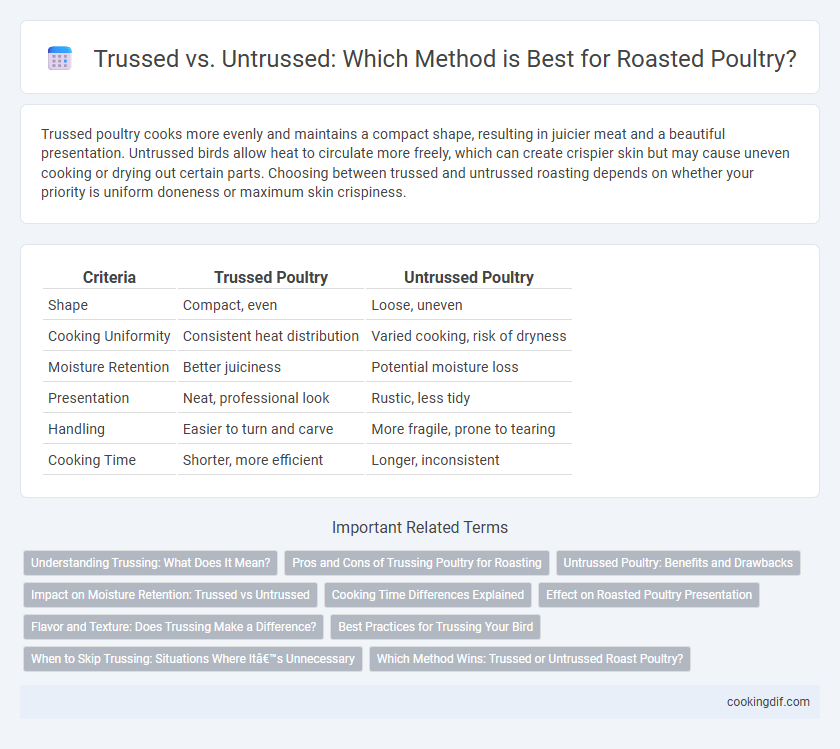Trussed poultry cooks more evenly and maintains a compact shape, resulting in juicier meat and a beautiful presentation. Untrussed birds allow heat to circulate more freely, which can create crispier skin but may cause uneven cooking or drying out certain parts. Choosing between trussed and untrussed roasting depends on whether your priority is uniform doneness or maximum skin crispiness.
Table of Comparison
| Criteria | Trussed Poultry | Untrussed Poultry |
|---|---|---|
| Shape | Compact, even | Loose, uneven |
| Cooking Uniformity | Consistent heat distribution | Varied cooking, risk of dryness |
| Moisture Retention | Better juiciness | Potential moisture loss |
| Presentation | Neat, professional look | Rustic, less tidy |
| Handling | Easier to turn and carve | More fragile, prone to tearing |
| Cooking Time | Shorter, more efficient | Longer, inconsistent |
Understanding Trussing: What Does It Mean?
Trussing poultry involves tying the bird with kitchen twine to secure the wings and legs close to the body, ensuring even cooking and an attractive presentation. This technique minimizes moisture loss and prevents extremities from drying out or burning during roasting. Untrussed birds allow for more exposure to heat, leading to potentially crispier skin but uneven cooking and drier meat.
Pros and Cons of Trussing Poultry for Roasting
Trussing poultry for roasting ensures even cooking by securing the wings and legs close to the body, which helps retain moisture and promotes a uniform shape for more attractive presentation. However, trussing can inhibit heat circulation around the bird, potentially leading to less crispy skin in some areas and requiring additional preparation time. Untrussed birds allow for quicker heat penetration and crispier skin but may cook unevenly and result in drier extremities.
Untrussed Poultry: Benefits and Drawbacks
Untrussed poultry allows for more even cooking and crispier skin as heat circulates freely around the bird, enhancing flavor development and texture. It also provides ease of carving since the legs and wings are not bound tightly against the body, making it convenient for serving. However, untrussed birds may cook unevenly, with extremities drying out faster, and can lose shape during roasting, potentially compromising presentation.
Impact on Moisture Retention: Trussed vs Untrussed
Trussing poultry tightly secures its shape, promoting even cooking which helps retain moisture by reducing exposed surface area and preventing juices from escaping. Untrussed birds allow for more air circulation around the meat, sometimes resulting in drier texture as heat penetrates unevenly and moisture evaporates more readily. Studies show trussed poultry typically yields juicier results due to minimized moisture loss during roasting, but personal preference and cooking method also influence the final moisture retention.
Cooking Time Differences Explained
Trussed poultry cooks more evenly by holding the legs and wings close to the body, resulting in a slightly longer cooking time due to reduced heat penetration. Untrussed birds cook faster as the legs and wings spread out, allowing heat to reach more surface area quicker. Understanding these differences helps optimize roasting time and ensures perfectly cooked, juicy poultry.
Effect on Roasted Poultry Presentation
Trussed poultry maintains a compact shape, ensuring even cooking and a polished, professional appearance ideal for formal presentations. Untrussed poultry offers a rustic, natural look with more exposed skin, resulting in a crispier texture but less uniform shape. The choice between trussed and untrussed directly affects the visual appeal and overall texture of the roasted poultry dish.
Flavor and Texture: Does Trussing Make a Difference?
Trussing poultry helps maintain even cooking and moisture retention, resulting in juicier meat with enhanced flavor concentration. Untrussed birds allow for more exposed surface area, which can create crispier skin but may lead to uneven texture and dryness in thicker parts. The choice between trussed and untrussed roasting ultimately affects the balance of tenderness, juiciness, and crispness in the final dish.
Best Practices for Trussing Your Bird
Secure poultry with kitchen twine to ensure even cooking and maintain shape, preventing wings and legs from spreading. Trussing helps retain moisture by keeping the bird compact, resulting in juicier meat and a more attractive presentation. Properly tying the legs and tucking the wings optimizes heat distribution and reduces cooking time for perfectly roasted poultry.
When to Skip Trussing: Situations Where It’s Unnecessary
Skipping trussing is advisable when roasting smaller birds or poultry with evenly sized pieces that cook uniformly without restrained limbs. In cases where you want a crispier skin all-around, untrussed poultry allows better air circulation and direct heat exposure, enhancing browning and texture. Additionally, untrussed birds offer easier access for seasoning or stuffing, making the cooking process simpler and more flexible.
Which Method Wins: Trussed or Untrussed Roast Poultry?
Trussed roast poultry ensures even cooking and maintains shape by securing the legs and wings close to the body, resulting in a moist and tender bird with a uniform appearance. Untrussed poultry allows for better air circulation around the meat, promoting crispier skin and faster cooking times, but may lead to uneven cooking or a less compact presentation. Choosing between trussed and untrussed methods depends on whether uniform cooking and presentation or crisp skin and speed are prioritized in the roasting process.
Trussed vs Untrussed for roasted poultry Infographic

 cookingdif.com
cookingdif.com